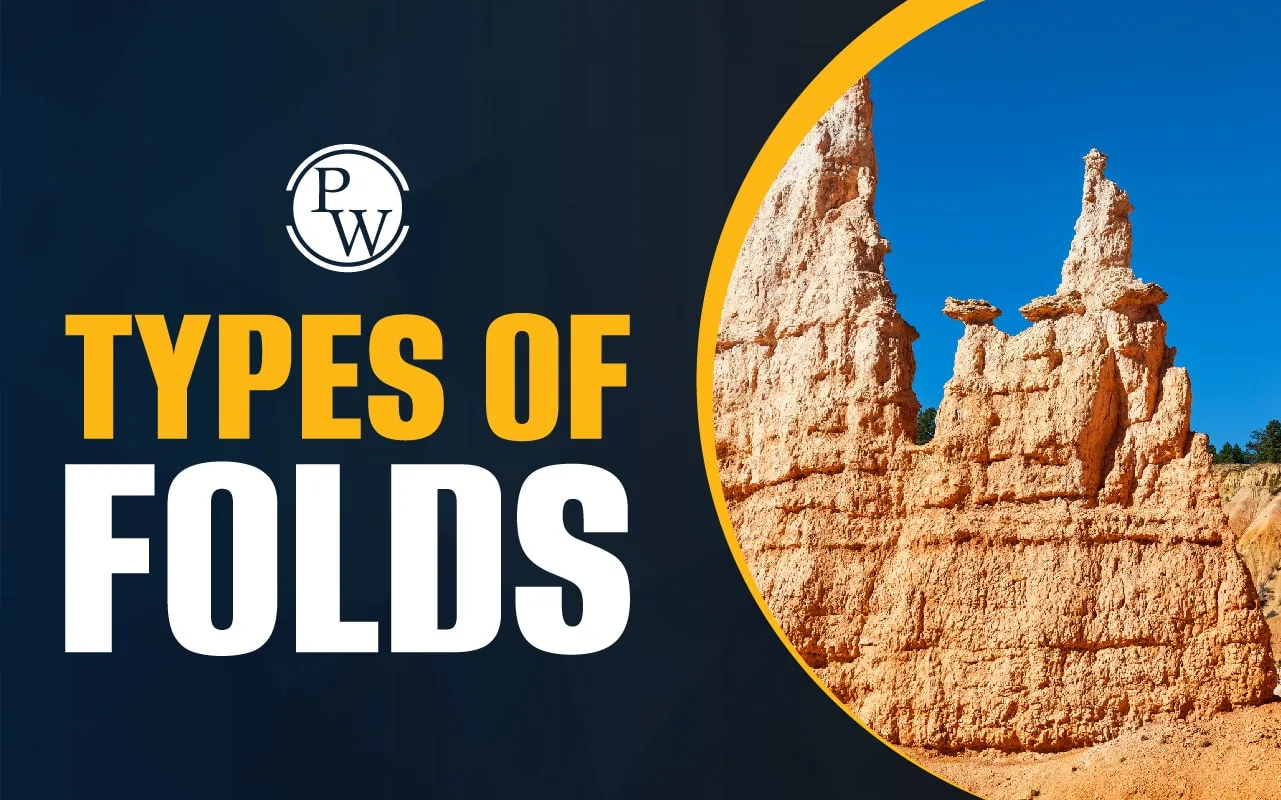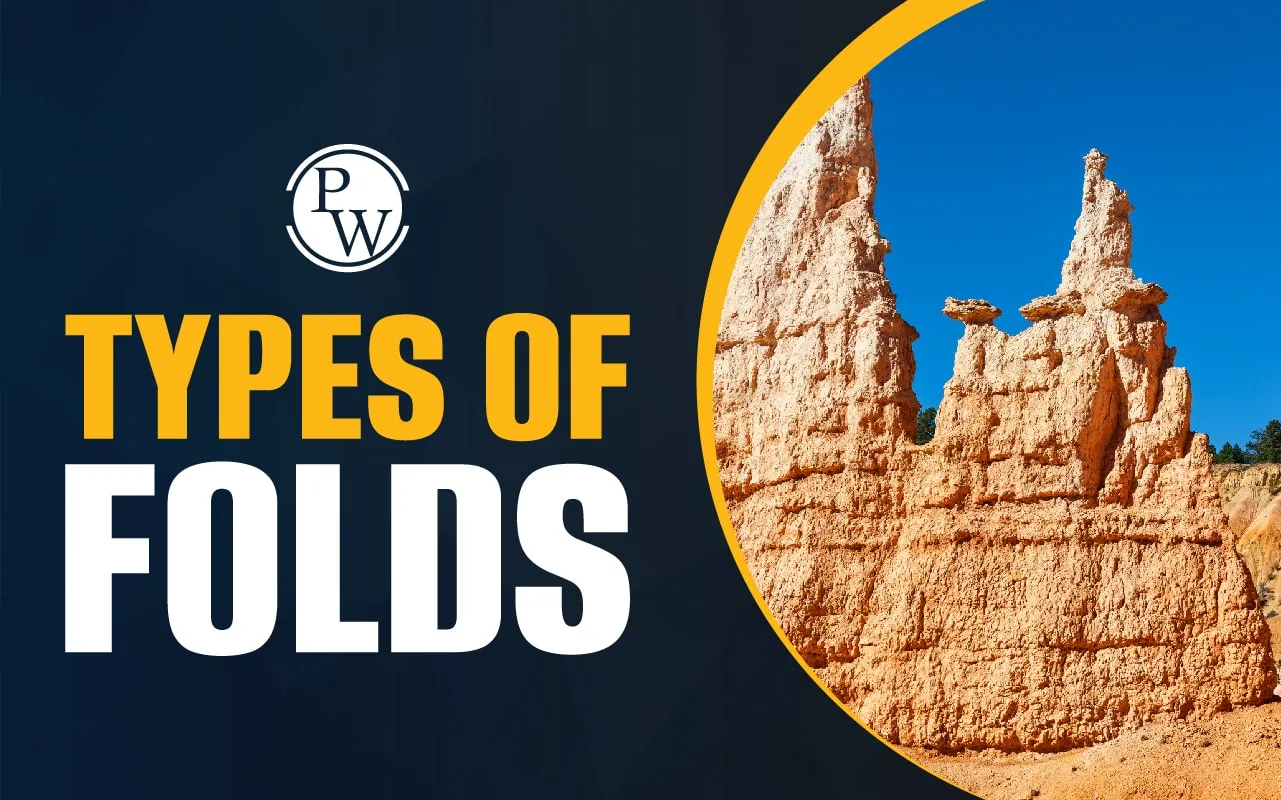

Types of Folds: Folds are bends or curves in layers of rock in the Earth's crust, caused by compressional forces. The rock layers bend due to pressure instead of breaking, usually from tectonic plate movements. Types of folds are classified based on their shape and the intensity of the forces that formed them. Read on to learn about different types of folds.
What Are Folds in Geography?
Folds are basically bends or curves in the layers of the Earth's crust. These bends happen when rocks are pushed from opposite sides. They mostly occur in areas where two tectonic plates meet. Instead of breaking, the rock layers bend under pressure. This bending of rock layers is what we call folding.
Folds can be small or very large. Some are visible in rock layers on hillsides. Others form massive fold mountains like the Himalayas. Folds are important in physical geography. They help us understand how the Earth's surface changes over time. Geologists study folds to know more about mountain formation, earthquakes, and plate tectonics.
Folds can tell us about the past movements of the Earth's crust and help in identifying oil, gas, and mineral deposits.
Also Read: Aeolian Landforms
How Folds Are Formed?
Folds form due to compressional forces in the Earth’s crust. When two tectonic plates move towards each other, the rocks in between get squeezed. If the rocks are flexible and the pressure is slow, they do not break. Instead, they bend and form folds.
This folding usually takes place deep within the Earth. Here, high temperature and pressure make rocks soft enough to bend. The process is slow and can take millions of years. Layers of sedimentary rocks are more likely to fold because they form in horizontal layers and are not too hard.
The direction and amount of pressure decide the type and shape of folds. Vertical pressure creates symmetrical folds. Uneven pressure makes asymmetrical folds or even overturned folds. This is why different fold types appear in different parts of the world.
Major Types of Folds
There are several types of folds. They are classified based on the shape, pressure direction, and symmetry. Here are some of the main types of folds:
1. Anticline
-
An anticline is a fold that arches upward like a rainbow.
-
The oldest rock layers lie at the centre.
-
The limbs of the fold dip away from the centre.
-
Example: The Appalachian Mountains, USA.
2. Syncline
-
A syncline is a fold that bends downward like a trough.
-
The youngest rocks are at the centre.
-
The limbs dip towards the centre.
-
Example: The Jura Mountains, France and Switzerland.
3. Monocline
-
A monocline is a simple bend in rock layers.
-
One side of the fold is steeper than the other.
-
It looks like a step.
-
Example: The Grand Canyon region, USA.
4. Overturned Fold
-
In this fold, one limb is pushed over the other.
-
Both limbs dip in the same direction.
-
Occurs due to strong compressional forces.
-
It can form complex mountain structures.
5. Recumbent Fold
-
A recumbent fold has horizontal limbs.
-
It looks like a lying-down fold.
-
Found in regions with extreme pressure.
-
Common in the Alps.
6. Isoclinal Fold
-
Both limbs of the fold are parallel.
-
The fold may be vertical or inclined.
-
Formed under strong compressional forces.
7. Chevron Fold
-
Looks like a zigzag pattern.
-
The folds have sharp hinges and straight limbs.
-
Seen in sedimentary rocks.
These types show how varied and complex the Earth’s crust can be. They also help geologists predict the nature of the Earth’s interior.
Difference Between Folds and Faults
Folds and faults are both results of stress in the Earth’s crust. But they are very different in how they form and behave.
| Feature | Folds | Faults |
| Type of Movement | Bending of rocks | Breaking and displacement of rocks |
| Cause | Compressional forces | Tensile or compressional forces |
| Result | Curved or bent rock layers | Rocks break and shift position |
| Depth | Usually deep in the crust | Can occur at any depth |
| Example | Himalayas (Fold) | San Andreas Fault, USA (Fault) |
Fold Mountain
Fold mountains are large mountains formed mainly by the folding of rock layers. They are created when two tectonic plates collide. The land between them gets squeezed. This pressure causes the sedimentary rocks to fold and rise up, forming long mountain ranges.
Fold mountains usually form over millions of years. They are some of the world’s highest and longest mountain ranges. These mountains often have parallel ridges and valleys. Fold mountains are rich in minerals, rivers, and forests. They are home to many people and are important for water and agriculture. Examples of fold mountains are:
-
The Himalayas: Formed by the collision of the Indian and Eurasian plates.
-
The Alps: Located in Europe, formed by African and Eurasian plates.
-
The Rockies: Found in North America.
-
The Andes: Formed along the west coast of South America.
Fold mountains show the power of tectonic movements. They are also evidence of the dynamic nature of our planet.
Ready to explore geography in more detail for the IAS exam? Join PW’s UPSC Online Courses!
Types of Folds FAQs
What is a fold in geography?
Which mountain range is an example of fold mountains?
What causes folds to form?
How are folds different from faults?
Why are folds important?

UPSC Coaching












